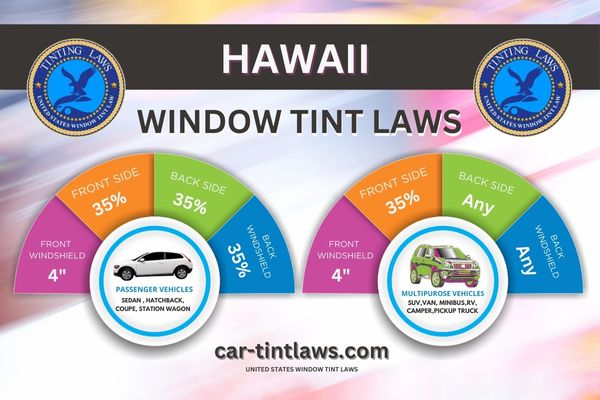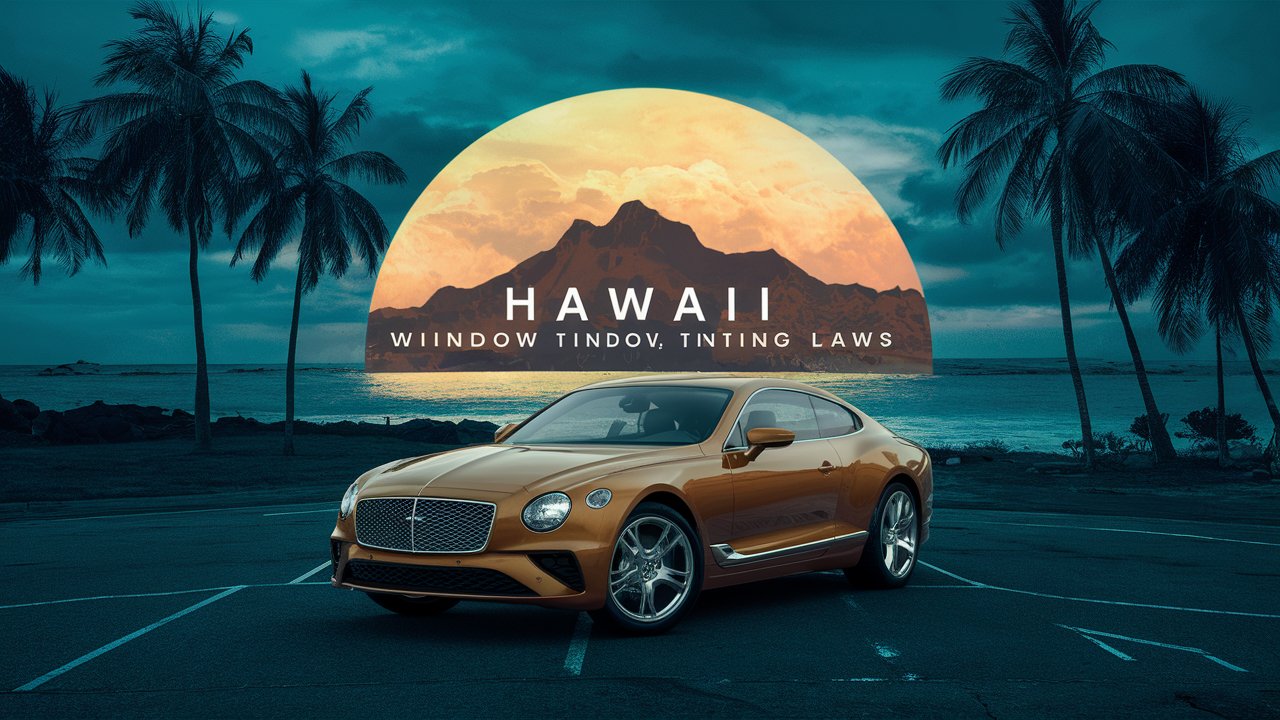You might think window tinting laws in Hawaii are straightforward, but there are several nuances you should be aware of to avoid hefty fines.
For instance, the percentage of visible light transmission (VLT) allowed varies notably depending on whether you drive a sedan, SUV, or van.
Plus, there are strict rules against using reflective or metallic tints.
With no medical exemptions and fines ranging from $250 to $500, you’ll want to make sure your vehicle complies not just for legal reasons, but also for enhanced UV protection and glare reduction.
So, what exactly are these specific percentages and restrictions?
Window Tint Darkness in Hawaii
When it comes to window tint darkness in Hawaii, you’ll need to know the specific requirements for different types of vehicles.
For sedans, the front side windows must allow more than 35% of light in, and the windshield should let in more than 70% light.
SUVs and vans have similar rules for the front side windows, but the back side and rear windows can have varying levels of darkness.
Tint darkness for sedans:
In Hawaii, sedans must adhere to specific tint regulations to ensure safety and visibility on the road. The rules are as follows:
- Windshield: Non-reflective tint is allowed on the top 4 inches of the windshield.
- Front Side windows: Must allow more than 35% of light in.
- Back Side windows: Must allow more than 35% of light in.
These regulations are in place to maintain adequate visibility for drivers and comply with Hawaii State laws. To confirm compliance, it is important to obtain a certificate from the installer verifying that the tint meets the Visible Light Transmission (VLT) requirements and other regulations. By following these rules, drivers can ensure they are driving safely and legally on Hawaii’s roads.
Tint darkness for SUV and Vans:
- Windshield: Non-reflective tint is allowed on the top 6 inches of the windshield.
- Front Side windows: Must allow more than 35% of light in.
- Back Side windows: No specific restrictions on darkness levels.
- Rear window: No specific restrictions on darkness levels.
Window Tint Reflection in Hawaii
When it comes to window tint reflection in Hawaii, it’s important to know that the law prohibits any metallic or mirrored appearance on the front side windows of sedans, SUVs, and vans.
This means you can’t use reflective tint on these windows, ensuring they don’t have a shiny or mirrored look.
Compliance with these regulations helps maintain safety and visibility on the roads.
Tint reflection for sedans:
- Front Side windows: Must not have a metallic or mirrored appearance.
- Back Side windows: Must not have a metallic or mirrored appearance.
Tint reflection for SUV and vans:
- Front Side windows: Should not have a metallic or mirrored appearance.
- Back Side windows: Should not have a metallic or mirrored appearance.
Other Hawaii window tint rules and regulations
- Medical Exemptions: Hawaii does not allow medical exemptions for window tinting.
- Tinting Identification Sticker: Hawaii does not require a tinting identification sticker.
- Penalties: Fines can be issued for violating tint laws in Hawaii.

Medical Exemptions for Window Tint Rules in Hawaii
Hawaii’s window tinting laws make exceptions for certain medical conditions, allowing drivers to apply for exemptions with a physician’s certification.
If you have medical conditions like Lupus, Albinism, or Xeroderma Pigmentosum, you can qualify for these medical exemptions.
The Hawaii window tint law acknowledges the need for darker tint in such cases to safeguard individuals from harmful UV rays.
To apply for an exemption, you’ll need a licensed physician to provide a medical certification stating the necessity of a darker tint for your condition.
This physician’s statement must clearly outline why the standard tint levels are insufficient for your health needs.
With the medical certification in hand, you can then submit your application for a darker tint exemption.
The process is straightforward but requires thorough documentation to guarantee your medical condition warrants the exception.
Remember, these exemptions are designed to help you stay safe and comfortable while driving, ensuring you belong to a community that values your well-being.
By following the proper steps and securing the necessary medical certification, you can legally have a darker tint on your vehicle windows, enhancing your protection against the sun’s rays.
Hawaii Window Tint Ticket Cost
While medical exemptions provide essential relief for some, it’s significant to comprehend the costs and other regulations associated with window tinting violations in Hawaii.
If you’re caught violating Hawaii’s tint laws, expect fines ranging from $250 to $500.
These fines are substantial, so confirming your vehicle complies with state laws can save you money and hassle.
In Hawaii, you’re required to have a compliance certificate from the tint installer.
This certificate proves your window film meets state regulations.
Additionally, if you tint your rear window, you must have dual side mirrors to maintain proper visibility.
Unlike some states, Hawaii doesn’t prohibit specific tint colors, giving you more flexibility in your choices.
However, manufacturers aren’t obligated to certify the tint films they sell in Hawaii, placing the responsibility on you to ensure conformity.
Side windows and other car windows must adhere to state guidelines, so it’s essential to understand these details to avoid fines.
Staying informed about both state and tint laws will help you avoid costly tickets and guarantee your vehicle meets all necessary regulations.
Hawaii Climate and Tinting Impact
Hawaii’s sunny climate makes window tinting essential for UV protection, heat reduction, and glare control.
You’ll find that tinting your car windows can greatly enhance interior comfort by reducing heat and glare, while also protecting against sun damage.
Understanding how these benefits align with Hawaii’s tinting laws will help you make informed decisions about the right tint darkness for your vehicle.
UV Protection Benefits
Given the tropical climate, you’re often exposed to high UV radiation levels, making window tinting essential for protecting against harmful rays.
Hawaii’s window tinting laws allow you to apply tints that offer effective UV protection, which is vital for both your health and the longevity of your vehicle’s interior.
The right tint can block a significant amount of UV rays, reducing the risk of skin damage and lowering the likelihood of skin cancer.
By investing in window tinting, you’re not just ensuring UV protection; you’re also safeguarding your car’s interior.
UV rays can cause fading, cracking, and discoloration of your vehicle’s upholstery and dashboard.
With proper window tints, you can maintain the appearance and value of your car, preventing costly repairs and replacements.
Moreover, window tinting contributes to a more comfortable driving experience.
By reducing UV exposure, tints help keep the interior temperature lower, making your daily commute more pleasant.
Following the window tinting laws in Hawaii guarantees that you stay compliant while reaping these benefits.
In a place where the sun shines intensely year-round, tinting your windows isn’t just a luxury; it’s a necessity for protection and comfort.
Heat Reduction Efficiency
In a place like Hawaii, where the sun blazes year-round, window tinting is essential for keeping your vehicle’s interior cool and comfortable.
The State’s warm climate makes car window tinting a practical choice for reducing heat.
Properly tinted windows can markedly cut down on the interior temperature during hot days, making your car a more pleasant environment.
Tinted windows are especially effective at blocking UV rays, which are a major contributor to heat buildup inside your vehicle.
By reducing this heat, you won’t have to rely as heavily on air conditioning, improving your car’s energy efficiency.
This not only enhances comfort but also protects the vehicle’s interior from sun damage, preserving its value.
Hawaii allows certain levels of visible light transmission (VLT) for car window tinting.
It’s important to follow State regulations to avoid penalties. If you have a medical condition requiring special tinting, the State provides allowances for medical exemptions to ensure you obtain the protection you need.
Choosing the right tint for your car can make a significant difference in heat reduction and overall comfort.
Make sure to understand the regulations and benefits to optimize your vehicle’s interior climate.
Glare and Visibility
The island’s unyielding sun can create intense glare, making window tinting essential for enhancing visibility and driving comfort.
In Hawaii’s sunny climate, glare and heat inside vehicles can become overwhelming.
Properly applied window tint can greatly reduce glare from sunlight, headlights, and reflections, improving driver visibility and overall safety.
Hawaii’s tinting laws and regulations are designed to make sure that while reducing glare and heat, visibility is not compromised.
The laws specify the allowable levels of tinting on different windows to balance glare reduction and clear visibility.
By adhering to these regulations in Hawaii, you can achieve best glare reduction without breaching legal standards.
Tinted windows also provide UV protection, shielding you and your passengers from harmful rays.
This not only protects your skin but also improves visibility by reducing the harsh light that can cause eye strain.
The regulations in Hawaii make certain that the tint used provides adequate UV protection while maintaining sufficient visibility for safe driving.
References
Hawaii Revised Statutes section 291-21.5: Regulation of motor vehicle sun-screening devices; penalty
Frequently Asked Questions
What Is the Darkest Legal Tint in Hawaii?
When considering window tinting, Hawaii laws state the darkest legal tint for front and rear side windows is 35% VLT.
This guarantees vehicle safety and visibility concerns are met, keeping you and your community safe.
What Percent Tint Is Illegal in Hawaii?
You’ll find that tint percentages less than 35% VLT are illegal in Hawaii due to visibility concerns.
While darker tints offer heat reduction, UV protection, and privacy, they don’t comply with Hawaii’s privacy regulations during the installation process.
How Much Is a Ticket for Illegal Tint in Hawaii?
If you get a ticket for illegal tint in Hawaii, the cost ranges from $250 to $500.
Law enforcement methods include inspections during traffic stops. Consider tint removal or visiting a reputable tint shop for exemptions and compliance.
What Is the Darkest Legal Tint?
You’re wondering about the darkest legal tint. For front windows, 35% VLT guarantees compliance with safety standards.
While darker tints offer heat reduction and UV protection, they can impact visibility. Choose tint options that balance customization and safety.
Conclusion
To sum up, adhering to Hawaii’s window tinting laws is essential for maintaining road safety and avoiding hefty fines ranging from $250 to $500.
By ensuring your tint darkness and reflection levels comply with state regulations, you can enhance UV protection, reduce glare, and increase driving comfort.
Although medical exemptions aren’t allowed, following these straightforward rules will help you stay within legal limits and enjoy the benefits of properly tinted windows in Hawaii’s sunny climate.
